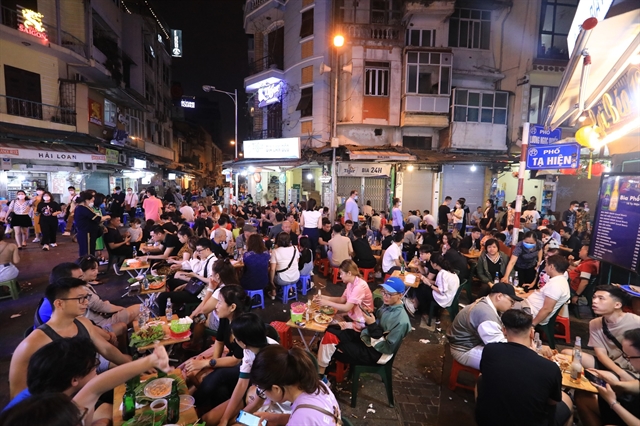 Society
Society

 |
Tạ Hiện Street is one of the nightlife spots attracting a large number of tourists in Hà Nội. VNA/VNS Photo
HÀ NỘI — Economic activities in urban areas have made many important contributions to the economic development of Hà Nội over the years.
However, the economic activities have not yet been commensurate with the potential and strengths of the capital city.
To maximise the potential of the urban economy and help accelerate the capital's economy associated with the goals of a green, modern and civilised city, urban planning must create conditions for urban economic development.
Urban construction planning and urban economic development are closely related. It means urban planning or investment must consider urban economic development and vice versa, and urban economic development must meet the requirements of urban management and development.
However, in Hà Nội this multi-dimensional mutual relationship has not been promoted, so the urban planning that aims to take full advantage of the capital city for development has not been implemented effectively.
Currently, Hà Nội’s urban planning has not yet properly allocated spaces for the development and management of various types of urban economies such as the night economy, sharing economy, circular economy, and digital economy.
“In recent times, Hà Nội had changes to exploit the potential of the night economy, but the spatial planning for this type of business has many shortcomings,” Dr Nguyễn Ngọc Sơn from the National Economics University told Kinh Tế & Đô Thị (Economic and Urban Affairs) newspaper.
“Specifically, due to lack of planning, many night-time businesses including restaurants, cafes and bars with loud music were located right in residential areas, badly affecting people,” Sơn said.
"From the current reality, it is necessary to plan separately the night economic zones that are not too far from the centre but not in residential areas, ensuring the connection with the urban centre but not affecting people.”
As for walking streets, due to a lack of synchronous and clear planning, there were not many cultural and art programmes, but the situation of vendors peddling to customers and tourists and littering in the streets adversely affected the environment, he said
Because of not being properly planned, many streets became chaotic. Shops encroached the streets, taking up space for pedestrians while the wider streets suitable for services were empty, he added.
A representative of the Hà Nội Department of Construction said that the work of urban economic development associated with urban embellishment and development of the city was still limited.
The service and commerce industry had been paid attention, but it had been far beyond the city’s potential, so it had not brought into full play the advantages of land resources and the real estate market.
In particular, the planning and building of satellite cities with separate functions such as industry, high technology, healthcare, and education that are important sectors for urban economic development had not yet been done.
Besides, developing housing projects for low-income people, renovating old and degraded apartments and building urban infrastructure had been still at a slow pace, he said.
According to experts on urban planning, to develop the urban economy, it is necessary to do planning well and complete the institutional system for urban development and management.
Architect Đào Ngọc Nghiêm, vice chairman of the Việt Nam Urban Development Planning Association, said that currently, the city was studying to do the capital planning from 2021 to 2030 in an integrated direction.
“This is not only an innovation in planning but also a favourable condition to promote the urban economic factor in the planning to identify key industries and fields of the city in accordance with the city’s conditions and reality,” Nghiêm said.
“This is also one of the goals of the new planning project to harmonise sustainable economic development with a green, civilised and modern capital city with cultural and human development ensuring national defence and security, social security and raising people's living standards as well.”
Meanwhile, former vice chairman of the Hà Nôi’s People’s Council, Lê Văn Hoạt, said that to promote efficiency in urban construction, urban residential areas and urban economic development, it was necessary to review construction planning, especially spaces for community and night services.
In particular, developing the urban infrastructure system with synchronisation, modernity, and connectivity is an important factor in connecting traffic axes in the central city with suburban districts.
Moreover, building more bridges across the Red (Hồng) River and expanding the public transport system, parking lots and bus transfer stations were priorities, he said.
Dr Trần Kim Chung, a former director of the Party Central Committee’s Economic Management Institute, recommended some solutions, of which land planning is the most important.
“There must be a comprehensive and synchronous planning of the areas that need to mobilise land resources to promote industrialisation and modernisation,” said Chung.
“All activities related to land, especially with acquisition, need to be based on the most important factor of approved planning. This should be considered as a prerequisite in the cycle of creating a land fund for attracting resources to promote industrialisation and modernisation.” — VNS